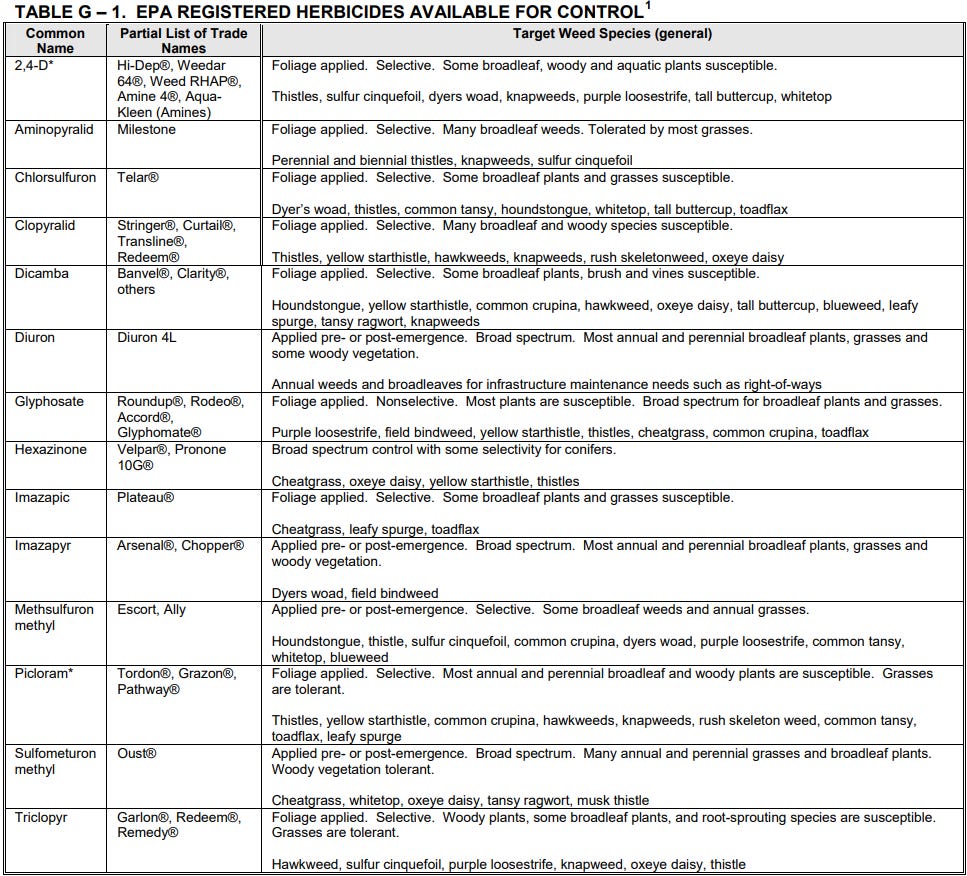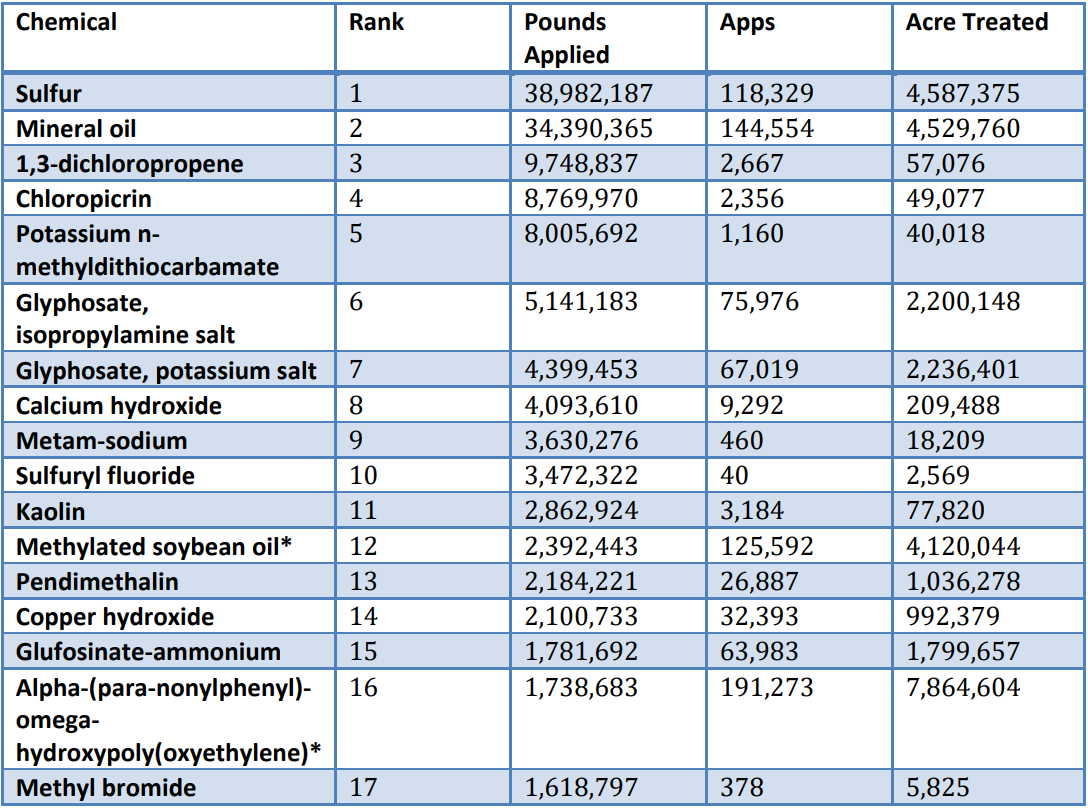Chemtrails Cause Wildfires
Aerial spraying, hack and squirt, & bad forestry making fires more intense!
I’ve heard it for years: “chemtrails are making forest fires more often and more intense.” Superficially, this seems like a silly claim because most people assume that when you say chemtrails, you mean clouds made by planes, however, the truth is often scarier than fiction.
In my previous article, I covered a 2940 page FOIA from the USAF detailing how C-130 aircraft were using chemical trails to fight mosquitos (disease vector control) and drop herbicides (modern Agent Orange defoliants), and how local municipalities were using ground based trucks with foggers to “chemtrail” your local neighborhood.
Today, conspiracy meets reality regarding forest wildfires. Very few people are aware of how the logging industry and forestry management services are using aerial spraying of herbicides and ground based machinery, in addition to manual “hack and squirt” and “cut and treat” methods to kill trees, leading to tinderboxes ripe for wildfires. We will explore all three methods and why they matter.
WHY are herbicides causing intense wildfires?
From fighting “invasive species” to making money in the logging industry, there are many reasons why people claim the necessity of removing trees, underbrush, and plants from forests. Loggers don’t want trees that don’t make money, so they kill trees that would compete with their cash crop. Others claim they are doing this to increase biodiversity or stop non-native plants from spreading. In all cases, killing plants and trees are actually accelerating the chance of blistering wildfires.
Researchers are growing increasingly critical of a common forest management practice, as studies show it may be causing fires to travel farther, faster.
"In 2017 and 2018 here in British Columbia, in both summers, we burned over 1.2 million hectares of forest," says Lori Daniels, a forest ecologist at the University of British Columbia.
"Diversifying the forest ... is a really effective way to create resilience in our landscape and resistance to these major fires we've been witnessing."
Meanwhile, much of the Canadian forestry industry is doing the opposite, spraying thousands of hectares of public forest with glyphosate each year to promote profitable coniferous growth, and eliminate hardwood species like aspen and birch.
The primary ingredient in the Monsanto-made herbicide Roundup, glyphosate has been under scrutiny in both agriculture and forestry for years. It remains widely used, because while softwood species like pine and spruce can tolerate a certain dosage of the chemical, glyphosate can be effective in eliminating the growth of hardwood trees for decades.
It's an efficient way for the forestry industry to streamline cut blocks so they contain the most profitable kinds of trees.
But aspen and birch burn more slowly than the glyphosate-resistant coniferous trees, and some experts say removing them is like quite literally stoking the fires that have plagued the province.
Source: Grooming forests could be making fires worse, researchers warn
See the full playlist: Aerial Herbicides and Forest Wildfires
Glyphosate is a clear favorite. In California, the Forest Service used 16,740 pounds of that herbicide on 5,726 acres in fiscal 2018, more than double the amount the prior year. In fiscal 2016, the agency used 3,805 pounds of glyphosate on 2,340 acres, according to the most recent reports filed for that region.
Herbicides are also just one of the service’s tools against weeds, and they’re not a blanket approach, said Rick Cooksey, acting director of forest health protection. He said common weeds include cheatgrass, which sprouts on fire-scorched land and is itself a wildfire risk, and "mile a minute" weed.Oregon and neighboring states are key in the debate, Trudeau told E&E News. "Forest management is dangerously reliant on herbicide use in the Pacific Northwest," he added.
The bigger risk in glyphosate may not be the herbicide itself, but the ingredients used in the mix to help it stick to weeds. The Forest Service in its risk assessment has said little about how chemicals play into forest management.
"These fires reflect all the mistakes we’ve made in forest management since we settled the West," Jim Trudeau said. "We need to be converting to a system that emulates nature, like the way fire would."
Source: Concerns grow about herbicide use in wildfires’ wake
Hack and Squirt and Cut and Treat
Planting the right trees and removing the wrong ones can both be part of effective deer habitat management. You might need to remove trees for timber stand improvement (selecting low-value tree species to allow sunlight and other resources to go toward understory growth or other high-value trees) or to control non-native invasive tree species that are consuming space that could be occupied by valuable native plants.
One of the simplest and most effective techniques for removing select trees and large shrubs without cutting them down is called the “hack-and-squirt” method, or bark injection. Quite simply, a manager hacks small cuts in the trunk of target trees and squirts an herbicide solution into the cut. “Cut-and-treat” is another method in which the entire tree or shrub is cut down with a chainsaw and the stump immediately painted with herbicide.
See the full playlist here Hack and Squirt - Killing Trees with Herbicides
Here is a lengthy presentation on hack and squirt for those who really want the details.
Finally, here is an aerial shot of the devastating effects of hack and squirt in Mendocino County, California.
Flyover of Mendocino Redwood Company industrial timber lands on July 22, 2015 to observe Hack 'n' Squirt forestry. Hack 'n' Squirt is a relatively new method of forestry whereby companies will apply a broad-based non-selective herbicide to weed out unwanted hardwood trees. The result is a conifer dominant forest with millions of standing, dead hardwoods. In this video the white trees are standing dead hardwood. Mendocino Redwood Company has killed over a million of these trees each year over the past decade. Aerial Support provided by LightHawk (www.lighthawk.org) For more information on California forest issues and ways to get involved check - www.forestsforever.org
Explosive Tinderboxes
In the drought-stricken west coast of the United States, poor forestry practices and monetary motivations are causing wildfires to burn hotter, move faster, and NONE OF THIS IS CAUSED BY CO2 BASED GLOBAL WARMING OR CLIMATE CHANGE. It is the failure of humans who intervene in natural processes, spraying forests with herbicides, killing standing trees, or chopping them down and leaving the forest floor covered in deadwood, adding fuel to the inevitable fires.
Get educated on your local forests. Find out who owns what, and what they are doing with it. You just may learn that you are also being sprayed with chemtrails or drinking water that has been poisoned by herbicides in a water shed near you.
It’s not just Roundup (glyphosate)
Glyphosate’s main use is in agriculture. Weedkillers containing it are used on nearly half of all planted acres of corn and soybeans in the U.S., though much of those are not grown for human consumption. They’re also used on acres of farmland where wheat, oats, fruits and cotton are grown. Pesticide residue testing from the FDA found glyphosate residues on a wide variety of crops, including oats, soybeans, cranberries, grapes, raisins, oranges, apples, cherries and beans. Data from the U.S. Geological Survey shows several counties across the country with higher than average glyphosate usage.
An NBC News analysis of 2019 USGS agricultural glyphosate usage data found:
An average of almost 130 pounds of glyphosate herbicides were sprayed per square mile in U.S. counties.
Nueces County, Texas, had the single highest glyphosate usage rate of U.S. counties, with more than 1,100 pounds sprayed per square mile.
Iowa and Illinois, where the most corn and soy crops are grown, accounted for 15% of national usage.
Southwestern and Northeastern states used the least glyphosate per square mile.
When we are talking about aerial application of herbicides, the list of potentially deadly chemicals rises exponentially:
Thirteen herbicides could be available for aerial application use on HTNF lands in Nevada: 2, 4-D amine, Indaziflam, Aminocycopyrachlor, Aminopyralid, Chlorsulfuron, Clopyralid, Glyphosate, Aquatic Glyphosate, Imazapic, Imazapyr, Metsulfuron-methyl, Rimsulfuron, and Triclopyr butoxyethyl ester (BEE).
Source: USDA Forest Service Invasive Plant Control Projects Using Aerial Applicaiton of Herbicide - PDF: Scoping and Notice of Proposed Action Humboldt-Toiyabe National Forest Invasive Plant Control Projects Using Aerial Application of Herbicide

Aerial spraying of herbicide chemtrails often drift in the wind and land elsewhere. Here are some examples from the state of California.
California Department of Pesticide Regulation Decisions
in performing an aerial pesticide application, applied pesticide over non-target property while workers were present. Farm Air Flying Service, Docket No 214, PDF.
aerial pesticide application that drifted onto a non-target vehicle traveling on a road alongside the application site. Alpine Helicopter Service, Docket No 213, PDF.
failing to perform his aerial pesticide application in a careful manner. Max Hanner, Docket No. 206, PDF.
aerial application that contaminated two individuals. Gomes Farm Air Service, Docket No. 196, PDF.
violated California Food and Agriculture Code section 12973 by using a pesticide in conflict with the label when they aerially sprayed Imidan 79-W to a tejocote orchard, a crop not listed on the label. Pacific Rotors, Inc., Docket No. 192.
applied Di-Syston by an aerial application in such a manner that caused the pesticide to drift into an adjacent apple orchard exposing farm workers. Alexander Ag. Flying Service, Docket No. 168.
contaminating nontarget property during an aerial application of a pesticide. T-Craft, Inc. Docket No. 161.
applying a pesticide in conflict with the label instructions–"Do not allow spray to drift from the application site and contact people, structures people occupy at any time and the associated property, parks and recreation areas, non-target crops, aquatic and wetland sites, woodlands, pastures, rangelands, or animals." Cavanagh Flying Service Docket No. 153.
Summary
Herbicides can increase the risk of wildfires in a number of ways, including:
Dead vegetation
Herbicides can leave behind dead stems and foliage that can increase the risk of fire in the short term.
Removing competing plants
Removing competing plants can make forests more susceptible to wildfires. For example, forest companies may use herbicides to remove aspen trees from spruce and pine crops, which can deprive moose of a winter food source and make wildfires more likely. Aspen trees are less likely to burn than spruce or pine and can cool the forest, so firefighters may even seek out aspen stands if a fire shifts.
Killing slow-burning trees
Some herbicides, like glyphosate, can kill slow-burning trees, which can make forests more vulnerable to wildfires.
Creating monocultures
Herbicides can create monocultures by killing all broad-leafed plants, which can increase the risk of wildfires.
MORE RESOURCES
Forest Herbicides, Monocultures Drive Wildfires, Harm Wild Species
PANNA: Herbicides to Fight Forest Fires? Pesticide Action Network North America
Elise Stolte: Herbicide, killing of aspen likely shares blame for growing wildfire damage
National Forest Herbicide Monitoring Project (California)
Agent Green & the Drug War: Biological Weapons, Calmatives, and Terrorism
US Forest Service proposes tree felling, herbicide use to promote oak growth in Nantahala
Confronting the Wildfire Crisis: Initial Landscape Investments (USDA FS)
EPA To Place Restrictions On The World’s Most Widely Used Herbicide (2015)






Thank you for all this research & reporting it! What an excellent resource to have to question authorities & gain more knowledge about this important subject. I watch chemtrails & those high flying white planes regularly. They never show up on my Plane Finder app, but I see them.
I appreciate your work & hope it will lead to the awareness we need for permanent change. Obviously, what they are doing isn’t working to solve the increasing wildfires. Oregon is getting hammered this year & Canada was bad the last couple years.
Citizens need to get involved in their local city politics & pay attention to state decisions regarding the forestry industry. We have a lot more power when we come together. Watch for U.N. Agenda 30 development in your local areas as well. ( sustainable, green, smart, equitable, are all a scam) It’s time to push back hard!
We got plenty of fires in Oregon!! July 17th had 100 fires in this Washington Oregon region.